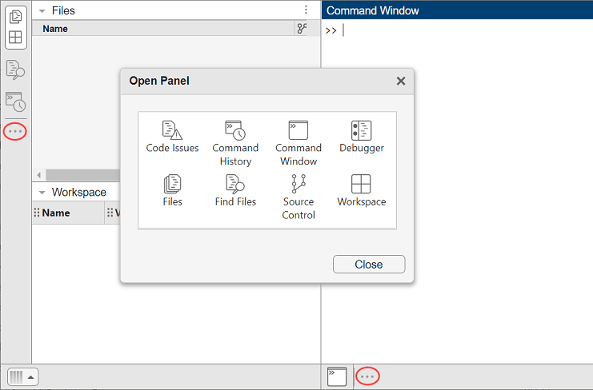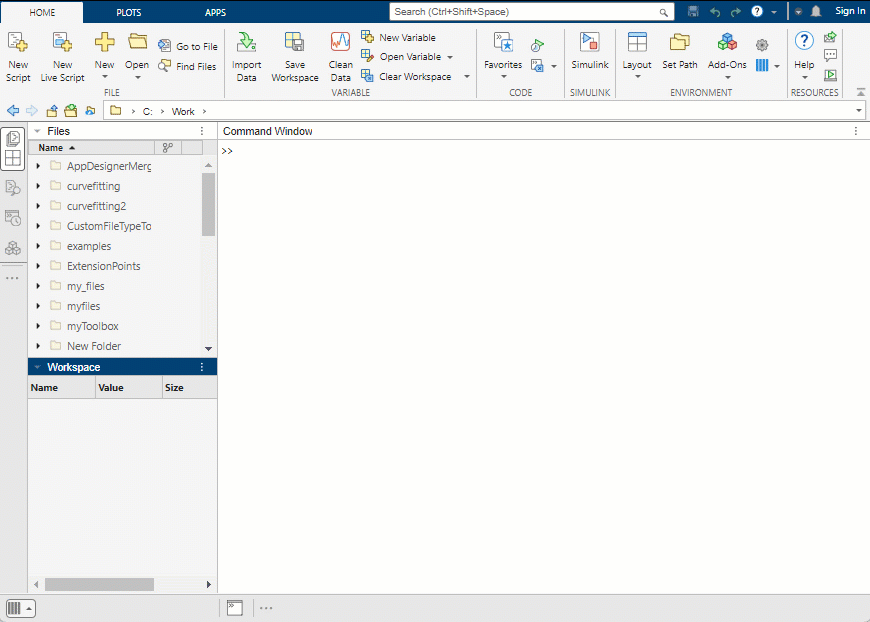配置桌面
默认情况下,MATLAB® 桌面配置为优化各种工作流。您可以通过调整布局来自定义桌面以更好地满足您的需要。
默认桌面布局
当您首次启动 MATLAB 时,桌面以其默认布局显示,该布局针对各种工作流进行了优化。桌面具有两栏布局,左侧为“文件”面板和“工作区”面板,右侧为命令行窗口,顶部为工具条。桌面左侧和底部的边栏显示停靠在桌面中的工具。
您可以使用边栏访问面板中的桌面工具并更改桌面布局。
要还原默认桌面布局,请转至主页选项卡,在环境部分中,选择布局 > 两栏(默认)。

显示和隐藏面板
要显示或隐藏面板,请点击边栏上的对应图标。要折叠组中的单个面板,请点击其标题栏左侧的箭头。

打开更多面板
要打开尚未打开的面板,请在任一边栏上点击“打开更多面板”按钮 。然后,在“打开面板”对话框中,从可用面板中进行选择。您也可以通过转至主页选项卡并在环境部分中点击布局按钮来显示常用面板。然后,在布局选项部分中,选择列表中的一个或多个选项。

组合和移动面板
您可以将面板进行组合,以便同时显示或隐藏它们。通过将一个面板图标拖到另一个面板图标旁边来对面板进行组合。
要移动面板,请将面板的标题栏或边栏图标拖到桌面的左侧、右侧或底部。例如,您可以通过将“工作区”面板的标题栏向右拖到右边栏来将“工作区”面板移至桌面的右侧。然后,您可以通过将“工作区”面板图标从右边栏拖到左边栏的“文件”面板图标来将“工作区”面板移回其原始位置。
您还可以将命令行窗口和“查找文件”面板移至桌面的中心,作为文档选项卡。例如,要将命令行窗口移至桌面中央,请点击命令行窗口右上角的命令行窗口操作按钮  ,然后选择移动命令行窗口 > 居中。
,然后选择移动命令行窗口 > 居中。

取消停靠面板和文档
要在单独的窗口中打开一个面板,请取消停靠该面板。您可以取消停靠“查找文件”面板、命令行窗口、编辑器和实时编辑器。您还可以取消停靠变量编辑器和图窗。
例如,要取消停靠命令行窗口,请点击命令行窗口右上角的“命令行窗口操作”按钮  ,然后选择取消停靠命令行窗口。命令行窗口将在单独的窗口中打开。要停靠命令行窗口,请选择停靠命令行窗口。
,然后选择取消停靠命令行窗口。命令行窗口将在单独的窗口中打开。要停靠命令行窗口,请选择停靠命令行窗口。

您还可以取消停靠单个文档,例如编辑器中打开的文件。例如,要取消停靠编辑器中打开的文件 myfile.m,请点击编辑器右上角的“文档操作”按钮  ,然后选择取消停靠 myfile.m。要停靠文档,请点击窗口右上角的“停靠”按钮。
,然后选择取消停靠 myfile.m。要停靠文档,请点击窗口右上角的“停靠”按钮。

重新排序和平铺文档
当您打开 MATLAB 文档时,它们会显示在相关联的工具中,例如编辑器或变量编辑器中。单个文档在工具中作为单独的选项卡打开。要查看工具中打开的文件的列表,请点击选项卡右侧的向下箭头。
要对工具中打开的文档重新排序,请将文档选项卡拖到不同位置。要按字母顺序对文档选项卡重新排序,请在工具的标题栏上点击“文档操作”按钮  ,然后选择按字母顺序排列。
,然后选择按字母顺序排列。
要平铺打开的文档,请点击“文档操作”按钮  ,点击全部平铺,然后选择一个平铺选项。例如,要并排查看两个代码文件,请点击“文档操作”按钮
,点击全部平铺,然后选择一个平铺选项。例如,要并排查看两个代码文件,请点击“文档操作”按钮  ,然后选择全部平铺 > 左/右。要移动一个平铺的文档,请将文档选项卡拖到另一个区域。如果您将其拖到已包含文档的区域,则您拖动的文档将覆盖其他文档。
,然后选择全部平铺 > 左/右。要移动一个平铺的文档,请将文档选项卡拖到另一个区域。如果您将其拖到已包含文档的区域,则您拖动的文档将覆盖其他文档。

要将选项卡的位置从其默认位置(文档顶部)更改,请点击“文档操作”按钮  ,点击选项卡位置,然后从可用选项中进行选择。例如,选择选项卡位置 > 左将选项卡移至文档的左侧。
,点击选项卡位置,然后从可用选项中进行选择。例如,选择选项卡位置 > 左将选项卡移至文档的左侧。

最小化工具条
要最小化 MATLAB 工具条,请在工具条的右下角点击“最小化工具条”按钮  。工具条将最小化,但其选项卡仍可见。要还原工具条,请点击其中一个选项卡,然后在工具条的右下角点击“还原工具条”按钮
。工具条将最小化,但其选项卡仍可见。要还原工具条,请点击其中一个选项卡,然后在工具条的右下角点击“还原工具条”按钮 ![]() 。
。

保存桌面布局
当您结束会话时,MATLAB 会保存您的当前桌面布局。因此,下次启动 MATLAB 时,桌面外观相同。
要保存布局以供将来使用,请转至主页选项卡,在环境部分中,选择布局 > 保存当前布局。MATLAB 将所有布局存储在设置文件夹中。要打开或管理保存的布局,请点击布局并选择您保存的布局,或右键点击以删除或重命名它。
某些工具(如变量编辑器)不会自动重新打开,即使它们在上次会话结束时处于打开状态也是如此。要在启动时打开特定工具,请使用启动选项。有关详细信息,请参阅指定启动选项。
还原默认桌面布局
在更改桌面布局后,您可以将桌面还原到其默认布局。转至主页选项卡,在环境部分中,选择布局 > 两栏(默认)。
自定义快速访问工具栏
快速访问工具栏提供对常用操作或项目的访问。此工具栏位于 MATLAB 桌面的右上角,即使您在不同 MATLAB 工具条选项卡之间导航时也始终可见。

要将工具条项目添加到快速访问工具栏,请右键点击该项目,然后选择添加到快速访问工具栏。您还可以转到快速访问工具栏并点击“常见控件”按钮  ,从常用控件列表中进行选择。要从快速访问工具栏中删除控件,请右键点击控件图标,然后选择从快速访问工具栏中删除。要排列快速访问工具栏中的控件,请将它们拖到所需位置。
,从常用控件列表中进行选择。要从快速访问工具栏中删除控件,请右键点击控件图标,然后选择从快速访问工具栏中删除。要排列快速访问工具栏中的控件,请将它们拖到所需位置。